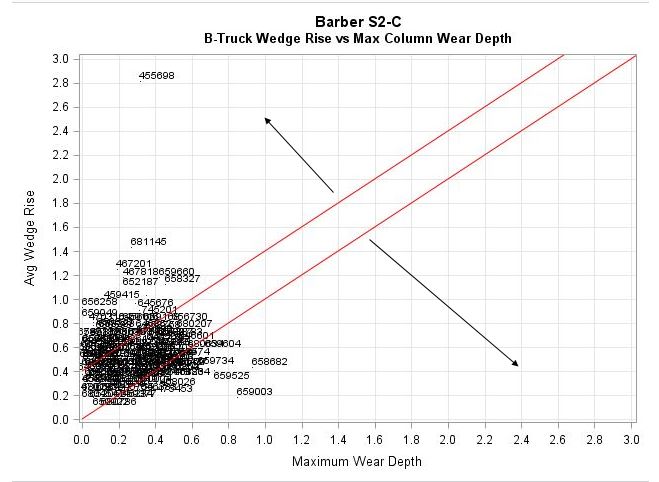- Home
- /
- Programming
- /
- Programming
- /
- Re: SAS Graph and Proc Print output
- RSS Feed
- Mark Topic as New
- Mark Topic as Read
- Float this Topic for Current User
- Bookmark
- Subscribe
- Mute
- Printer Friendly Page
- Mark as New
- Bookmark
- Subscribe
- Mute
- RSS Feed
- Permalink
- Report Inappropriate Content
I have the following graph:
i want only the data points that are above and below those two lines (arrows shown to indicate).
i want to be able to use proc print to show these data points that fall above or below those lines.
i am having a hard time figuring out how to do this. i have defined the lines in the data set, and then defined them in sgplot so they show up on the graph. is there any way i can take the 'slope' of the line and apply it to a where statement in proc print so i get only those values above/below the lines?
data work.wr_wp_combined_ELG;
set work.wr_wp_combined_ELG end=end;
by carnum;
if _n_=1 then do;
lx=0;
ly=0;
lj=0;
lk=0.4;
end;
if end then do;
lx=3;
ly=3;
lj=3;
lk=3.4;
end;
run;
title1 "Barber S2-C";
title2 "B-Truck Wedge Rise vs Max Column Wear Depth";
proc sgplot data=work.wr_wp_combined_ELG noautolegend;
scatter x=wp_max_b y=WR_truck_B / datalabel=carnum datalabelattrs=(size=10) MARKERATTRS=(SIZE=2);
series x=lx y=ly / lineattrs=(color=red) ;
series x=lj y=lk / lineattrs=(color=red);
xaxis values=(0 to 3 by .2) label="Maximum Wear Depth" grid;
yaxis values=(0 to 3 by .2) label="Avg Wedge Rise" grid;
run;
title;
proc print data=work.wr_wp_combined_ELG noobs;
var carnum inspection_date wp_max_b WR_truck_B;
******some sort of where statement here???***********
title "All Car Numbers. Might need to do a manual analysis of those that fit criteria";
run;
title;
- Mark as New
- Bookmark
- Subscribe
- Mute
- RSS Feed
- Permalink
- Report Inappropriate Content
The generic form would be:
Where y-value < (lower bound) or y-value > (upper bound);
lower bound and upper bound would be expressed as a function of the X variable, the ever populat mx + b with m the slope b the intersept.
where WR_truck_B < (m*wp_max_b +lowerb) or WR_truck_B >(m*wp_max_b + upperb);
April 27 – 30 | Gaylord Texan | Grapevine, Texas
Registration is open
Walk in ready to learn. Walk out ready to deliver. This is the data and AI conference you can't afford to miss.
Register now and lock in 2025 pricing—just $495!
Learn how use the CAT functions in SAS to join values from multiple variables into a single value.
Find more tutorials on the SAS Users YouTube channel.
SAS Training: Just a Click Away
Ready to level-up your skills? Choose your own adventure.



